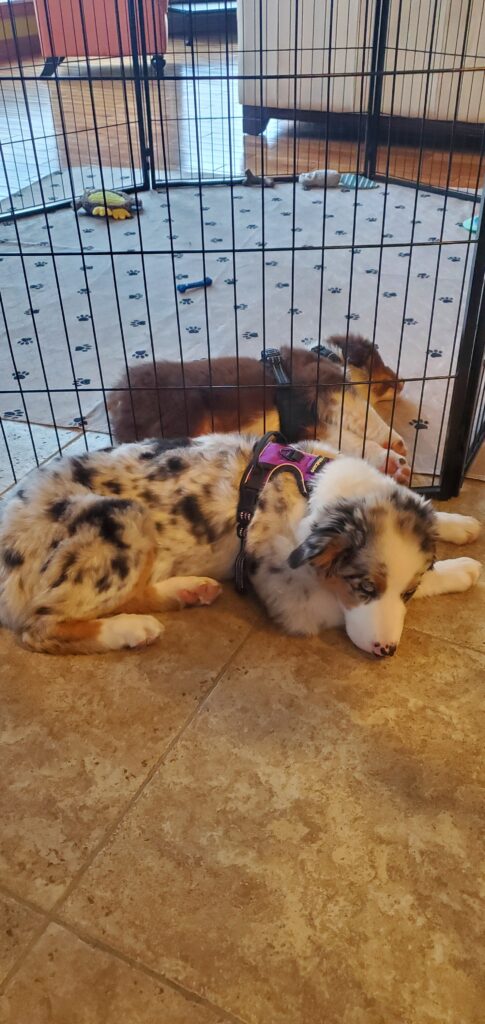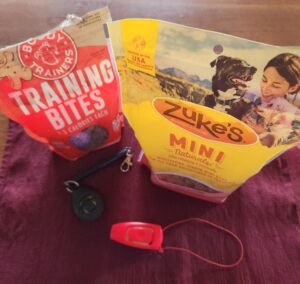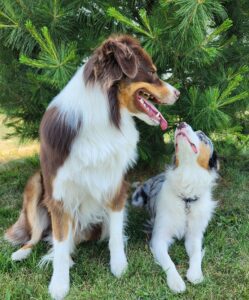We all desire a well-mannered canine companion, one that doesn’t wreak havoc around the house and understands where to do their business. Crate training for puppies is a fundamental aspect of achieving this and I have nine tips on crate training to help you. A crate not only provides a secure space for your puppy but also establishes a sense of ownership and belonging. Additionally, crates serve as valuable tools for housebreaking, as puppies instinctively avoid soiling their sleeping area. When introduced properly, crates become cozy retreats where puppies can relax, unwind, and feel secure amidst the hustle and bustle of daily life.
While some may perceive crates as confining, dogs, by nature, are den animals and often find comfort in small, enclosed spaces. When introduced to crates from an early age, puppies can associate them with security and tranquility, thus aiding in anxiety reduction.
Tip 1:
Selecting the suitable crate for your puppy and choosing the right crate is important. Keep in mind the durability, comfort, and adaptability to your training regimen. Tailor the crate type to your puppies preferences, whether they prefer the coziness of kennel-style crates or the openness of wire crates. Ensure the crate’s size matches your puppies adult dimensions and utilize dividers to adjust the space as needed. Additionally, consider the crate’s portability for travel and ease of cleaning for maintenance purposes.
Tip 2:
Cultivating the right mindset for crate training and establishing a relaxed association with the crate is key. Introduce the crate during moments of calmness to encourage its perception as a place for rest. Gradually increase the duration of time spent in the crate, starting with short intervals and progressively extending them. Incorporate positive reinforcement techniques, such as praise and treats, to reinforce desirable behaviors associated with crate use.
Tip 3:
Ensure comfort in the crate. While some puppies may enjoy plush bedding, it’s essential to consider individual preferences. Experiment with different bedding options to determine what suits your puppy best. Remember, puppies may prefer sleeping on the crate mat itself, as they often favor firm surfaces. Additionally, ensure proper ventilation within the crate to maintain a comfortable environment, especially during warmer months.
Tip 4:
Reward crate use wit positive reinforcement. Reward your puppy with engaging activities, such as a frozen peanut butter-filled KONG toy, to foster enjoyment of crate time. This association promotes longer crate stays while making the experience enjoyable for your puppy. Incorporate interactive toys and puzzle feeders to provide mental stimulation during crate time, further enhancing your puppies overall well-being.
Tip 5:
Monitor crate time and balance the time spent inside the crate with outdoor activities. Avoid prolonged periods of confinement to prevent accidents and discomfort for your puppy. Incorporate regular potty breaks and exercise sessions to ensure your puppies physical and mental needs are met. Monitor your puppies behavior and adjust crate time accordingly to maintain a healthy routine.
Tip 6:
Incorporating crate games makes crate time enjoyable. Integrating crate games into play sessions, such as hiding treats or playing fetch with the crate as a focal point. These interactive games not only keep your puppy entertained but also reinforce positive associations with the crate, making it a welcoming and enjoyable space for your companion.
Tip 7:
Ensuring safety in the crate. It’s importance to remove collars and tags to prevent potential hazards, such as strangulation. Additionally, ensure the crate is securely positioned and free from any sharp objects or loose wires that could pose a risk to your puppies safety. Regularly inspect the crate for signs of wear and tear, and replace any damaged components promptly.
Tip 8:
Gradually extend crate time. Increase the crate time in small increments to acclimate your puppy to longer stays. Utilize remote monitoring devices to assess your puppies behavior in your absence and adjust training accordingly. Start with short intervals of crate time and gradually extend them as your puppy becomes more comfortable and relaxed. Provide plenty of positive reinforcement and rewards to encourage desirable behaviors and promote a positive association with the crate.
Tip 9:
Patience and persistence. Crate training requires time and patience. Maintaining consistency and remaining calm throughout the process is important. Celebrate small victories and progress milestones, and be patient with setbacks or challenges. With dedication and a structured approach, your puppy will eventually embrace crate time as a positive experience, leading to a well-behaved and contented companion.
Conclusion
Crate training can be a valuable tool for fostering a sense of security and providing a safe space for your dog. By following these nine tips on crate training, you can ensure a positive experience for both you and your companion. Remember to be patient, consistent, and attentive to your puppies needs throughout the process, and soon enough, your dog will view their crate as a comfortable retreat rather than a confinement.








